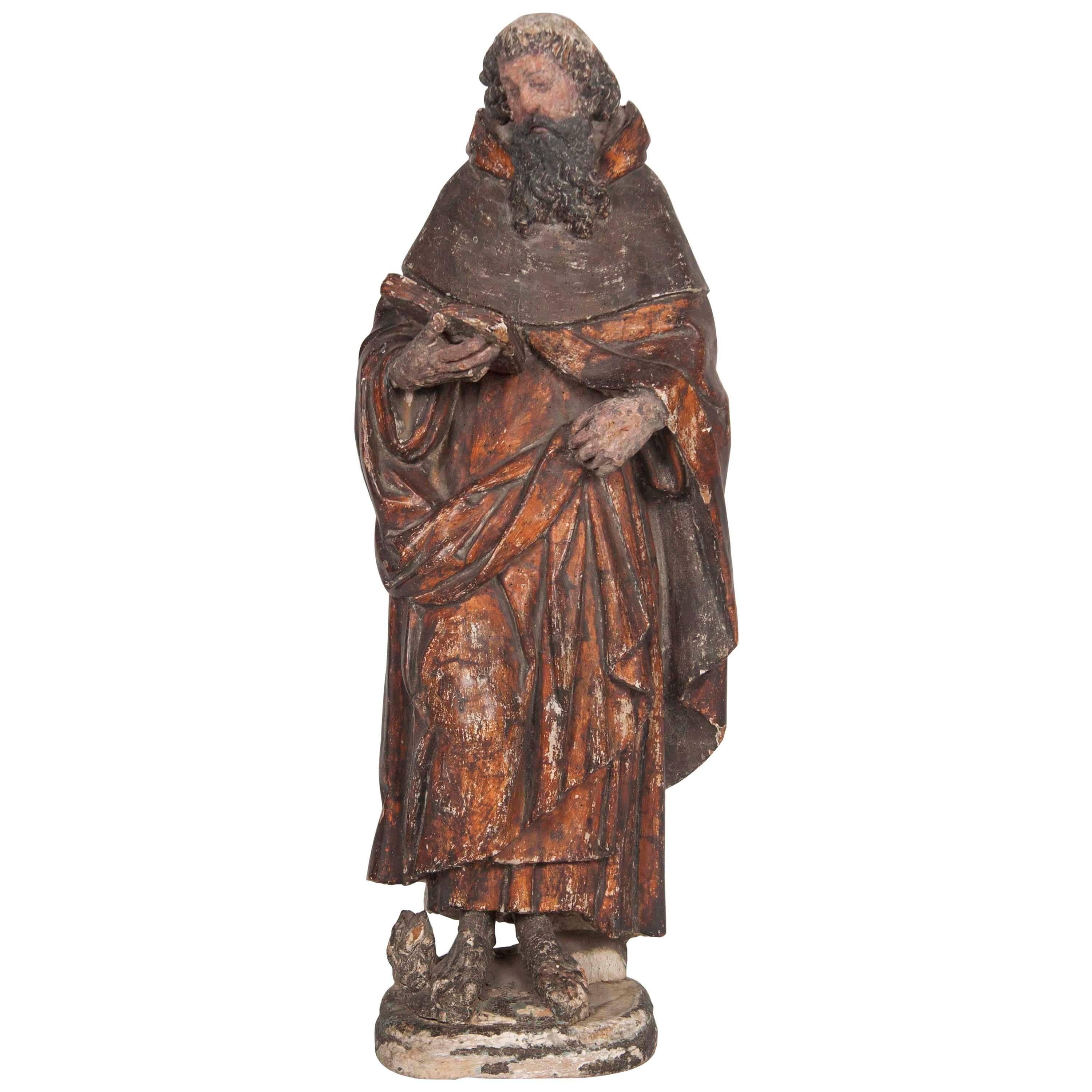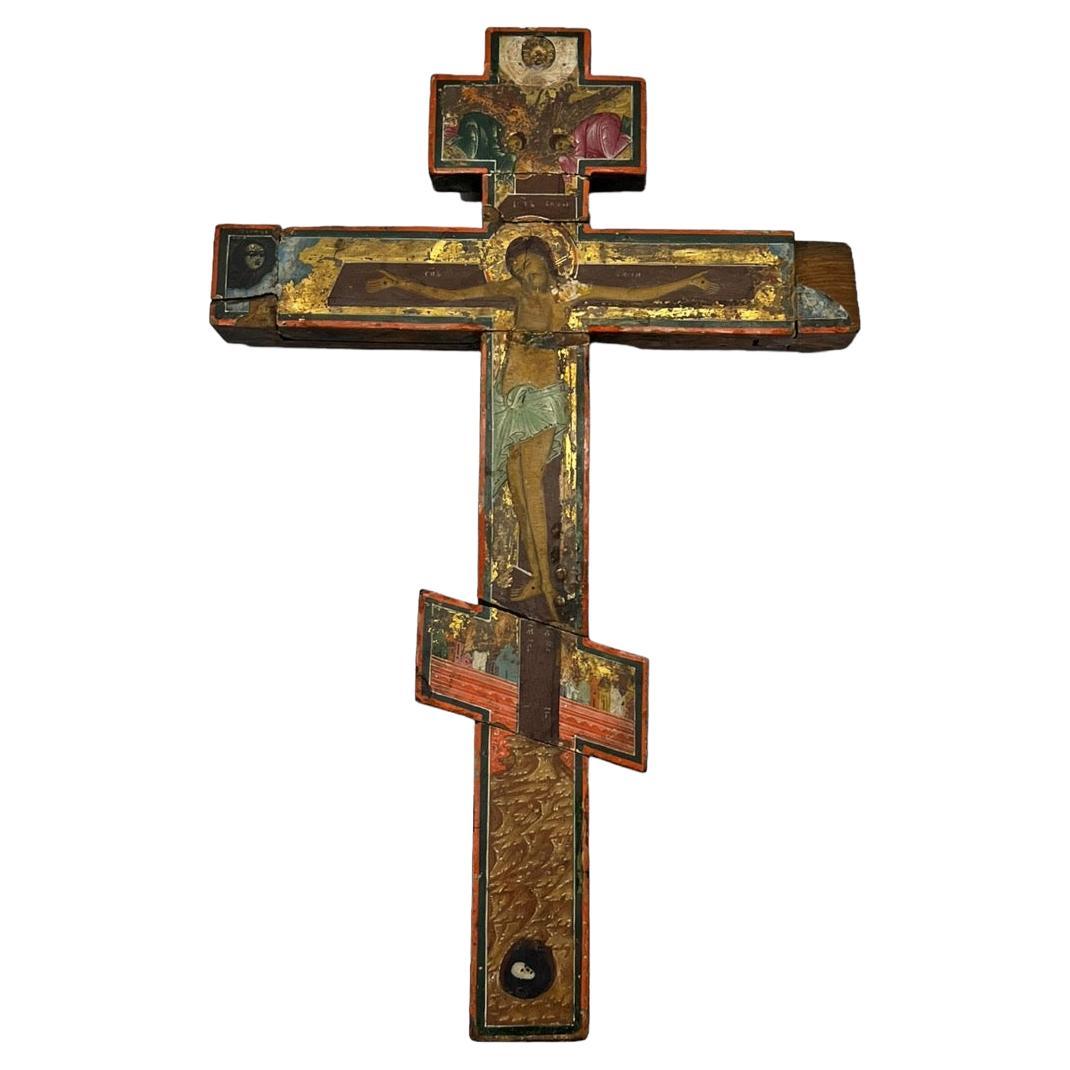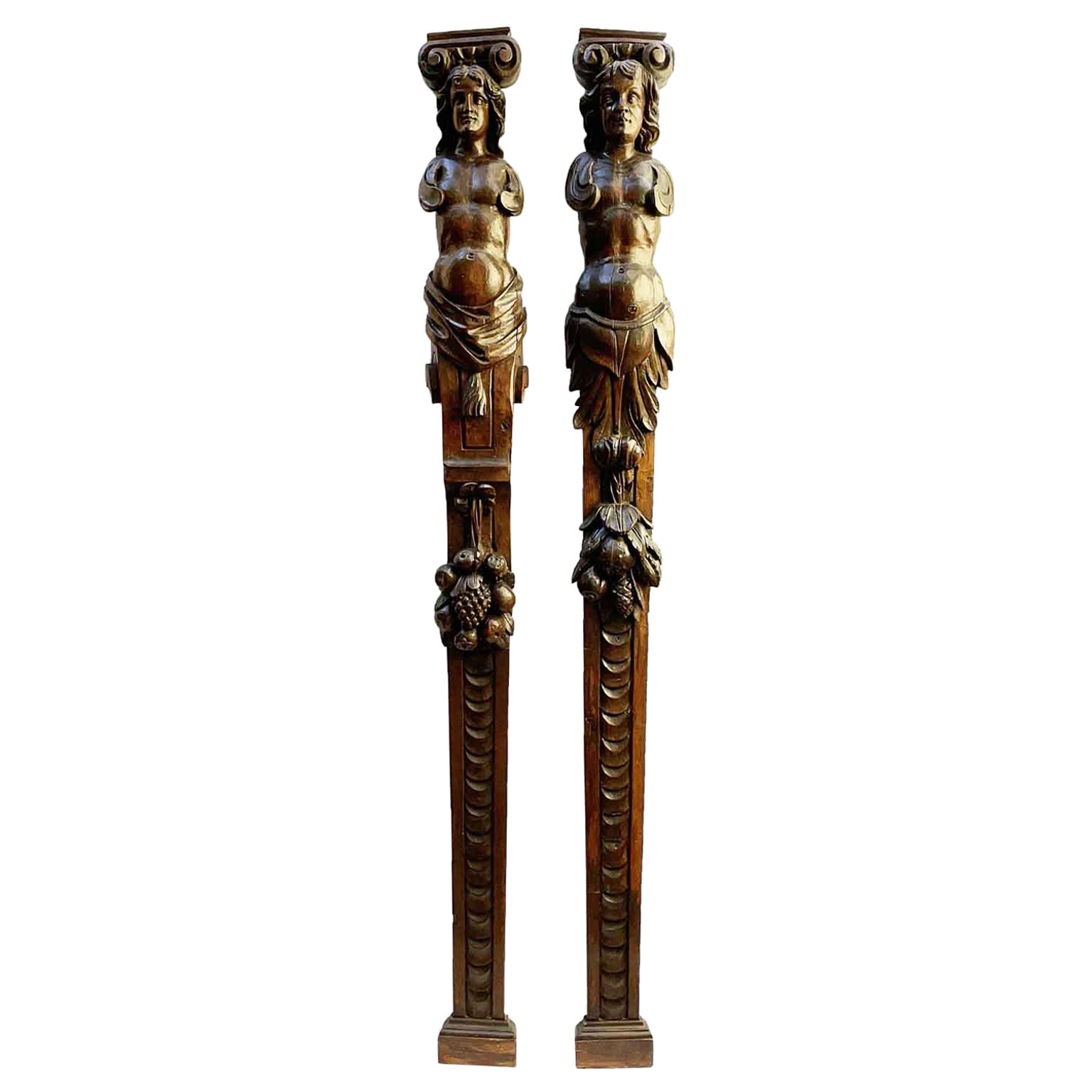Items Similar to renaissance wooden candelabrum and painted cross - Umbria, 16th century
Want more images or videos?
Request additional images or videos from the seller
1 of 8
renaissance wooden candelabrum and painted cross - Umbria, 16th century
About the Item
Base of a carved wooden candelabrum, polychrome and gilded; cross painted on both sides.
Umbria or Tuscany, 16th century
136 x 43,5 x 30 cm
(The cross and the base of the candelabrum were later assembled)
The base of the candelabrum is intricately carved and adorned with polychrome and gilded finishes. The shafts take on the shape of balusters reminiscent of ancient columns, feature ornate foliage decorations, garlands and winged cherub faces. The feet are crafted in the likeness of lion paws. The base is further embellished with depictions of four saint martyrs, among them Saint Barbara and Saint Catherine of Alexandria. The plasticity of the figures, outlined with strong contour lines, the clear and vibrant colors, are stylistic elements linked to the Umbrian tradition of the sixteenth century.The precisely defined and elegant drawing, along with the clear color palette applied with refined chiaroscuro modulations, became the signature of a style that would leave a lasting mark on the era to come. This is exemplified by a preference for vibrant, multicolored images, accentuated in this case by the use of red and pink in the saint's attire.
A notable addition, introduced later, is a polylobed cross painted on both sides. On one side, the Crucifixion is vividly portrayed:The treatment of the corpus itself is in line with High Medieval practice, emphasizing pathos by showing Jesus dead, his arms sagging from the weight of the body. The upper section displaying a pelican pecks at her breast to feed her young with her own blood; a symbol of the sacrifice of Christ on the cross whose body and blood similarly nourishes the celebrant during Mass.
The lower part depicts Golgotha. On the reverse side, the Resurrection is artistically presented in a Renaissance iconography, reminiscent of the renowned composition painted by Piero della Francesca, now housed in the Civic Museum of Sansepolcro. In terms of composition, with the frontal depiction of Christ holding the banner, this motif became particularly widespread in central Italy, spanning from Tuscany to Umbria throughout the 16th century..
The double-sided construction suggests that it may also have been carried in liturgical processions. In Umbria from the 14th century, the use of portable crosses painted on both sides had become a widespread practice, aimed at satisfying the monastic clientele that had significantly increased following the establishment of new religious communities.
The earliest surviving Tuscan painted crucifix represent Christ as Christus Triumphans, or the “Triumphant Christ” with his head up and eyes open. This form was supplanted in the 13th century with the Christus Patiens, or “Suffering Christ” type who is shown often with his head fallen on his shoulder and his eyes closed, as In our cross. The iconography of the suffering Christ appears to have developed out of a new interest in Christ’s human nature, the development of the feast of Corpus Christi and with increased importance given to the Eucharist. The process of humanizing the figure of Christ reaches its peak with the abandonment of all the previous expressive conventions in favor of more realistic details we can observe in this Crucifix, such as the swollen belly, the arms stretched to the limit of muscle tearing, the body falling heavily forward, the abundant blood on
the wounds, and the cross firmly embedded in the rock of Calvary.
It's worth noting that Renaissance candelabra often underwent later modifications, as in this case the addition of the polylobed cross. This adjustment, while postdating the original creation, did not diminish the artistic value. Instead, they showcased the evolving tastes and preferences of subsequent generations, creating a dialogue between different periods ans tastes.
Large in proportion and richly carved, this candlestick base display great magnificence and artistic skills. The combination of purely decorative scroll-work and pictorial form is typical of 16th century Renaissance decoration.
As much as candelabra were used to sanctified Christian objects, they were also unmistakably associated with antiquity and pagan worship in the fifteenth and sixteenth century.
Candelabra both for illumination and burning incense, were widely used in antiquity and, like many Roman decorative objects, they came in extremely diverse forms. A walk down the Galleria dei Candelabri at the Vatican Museums gives a taste of this seemingly endless variety of marble candelabra composed of natural and artificial component parts.
In the fifteenth century, when candelabra became part of a larger lexicon of all ‘antica forms, they appear most commonly in sacred settings. Many of the earliest surviving examples, were produced by artists from Tuscany, and it is probably there that painters and sculptors first widely explored the potential of the classically inspired candelabrum.
This candelabra, adorned with antique classic forms, embody the spirit of the Renaissance, blending innovation with intricate designs inspired by ancient Roman aesthetics. The use of classic forms, including balusters, garlands, and acanthus leaves, reflected a conscious effort to evoke the grandeur of antiquity.
The Renaissance candelabrum adorned with antique classic forms is a testament to the period's fascination with the past and its commitment to artistic excellence. The seamless integration of classical aesthetics into functional objects like candelabra not only illuminated spaces but also illuminated the enduring appeal of ancient beauty.
Bibliographie :
H. BELTING, L’arte e il suo pubblico. Funzione e forme delle antiche immagini della passione, introduzione di G. Cusatelli, Bologna 1986
WALTER A. DYER, Furniture of the Italian Renaissance, Arts & Decoration (1910-1918), Vol. 7, No. 3 (JANUARY, 1917), pp. 131-134
Paul Davies and David Hemsoll,“Renaissance Balusters and the Antique,”Architectural History 26,1983
E. SANDERBERG VAVALÀ, La croce dipinta italiana, Verona 1929, II ed. Roma 1980,
Elvio Longhi, La passione degli umbri, Crocifissi di legno tra Medioevo e Rinascimento, 2021
- Dimensions:Height: 53.55 in (136 cm)Width: 17.13 in (43.5 cm)Depth: 11.82 in (30 cm)
- Style:Renaissance (Of the Period)
- Materials and Techniques:
- Place of Origin:
- Period:
- Date of Manufacture:16th century
- Condition:Wear consistent with age and use.
- Seller Location:Bruxelles, BE
- Reference Number:1stDibs: LU6666238299302
About the Seller
5.0
Vetted Seller
These experienced sellers undergo a comprehensive evaluation by our team of in-house experts.
1stDibs seller since 2022
6 sales on 1stDibs
Typical response time: 7 hours
- ShippingRetrieving quote...Ships From: Bruxelles, Belgium
- Return PolicyA return for this item may be initiated within 3 days of delivery.
More From This SellerView All
- Griffin Head, Italy, 16th CenturyLocated in Bruxelles, BEGriffin head Italy, 16th century On a modern metal stand Measures: 20 x 29 x 21 cm (without the stand) The griffin is a legendary creature with the body of a lion, the head an...Category
Antique 16th Century Italian Renaissance Animal Sculptures
MaterialsMarble
- Group of Altarpiece - Antwerpen, 16th centuryLocated in Bruxelles, BEGroup of altarpiece representing the life of a Saint, Saint Renualde? Engraved by the sign of Antwerp hand on the hat of the central character Carved oak, traces of polychromy Fir...Category
Antique 16th Century Belgian Renaissance Figurative Sculptures
MaterialsOak
- Massacre of the Innocents, Normandy, Late 16th CenturyLocated in Bruxelles, BEThe Massacre of the Innocents Carved oak panel Normandy, late 16th century (Collection labels on the back) Measures: 43,5 x 61 cm.Category
Antique 16th Century French Renaissance Wall-mounted Sculptures
MaterialsOak
- Bronze Mortar, Tuscany, Second Half of 16th CenturyLocated in Bruxelles, BEBronze mortar with garlands, flowers and putti - Tuscany , second half of 17th century. Measures: height 10 diameter : 13 cm Artisans and healers used mortars for grinding food...Category
Antique 16th Century Italian Renaissance Scientific Instruments
MaterialsBronze
- 16th century Brussels tapestry - The Story of DavidLocated in Bruxelles, BE16th century Brussels tapestry The Story of David Brabant, 16th Century Monogram at the bottom left. 320 x 250 cm This splendid Brussels tapestry, crafted from wool and silk during ...Category
Antique 16th Century Belgian Renaissance Tapestries
MaterialsWool, Silk
- Cerberus, Italy, 17th CenturyLocated in Bruxelles, BECerberus Black painted stone Italy, 17th century Measures: 80 x 69 x 36cm (one head missing) Cerberus, cruel monster, fierce and strange, Through his wide threefold throat barks as a dog Over the multitude immers'd beneath. His eyes glare crimson, black his unctuous beard, His belly large, and claw'd the hands, with which He tears the spirits, flays them, and their limbs Piecemeal disparts (Dante, Inferno, Canto VI). Cerberus figure seated, in his role of ferocious guardian of the underworld; he shows a nervous musculature, an adherent skin which reveals the ribs, long and robust limbs; his heads are broad and the eyes set well apart. Painted in black to amplify his menacing look, the infernal guardian is depicted with his famous attributes, writhing his heads, growling and barking furiously. Cerberus, in Greek mythology, was the monstrous watchdog of the underworld – also known as the “hound of Hades” – preventing the dead from leaving, and making sure that those who entered never left. A child of Typhon and Echidna, he was part of a monstrous family, which included Orthus, the Lernaean Hydra, and the Chimaera as well. Only on three occasions Cerberus was tricked by visitors of Hades: Heracles did it with his strength, Orpheus with his music. In "The Inferno", Dante places Cerberus as the guardian of the third circle of Hell. With his three mouths, Dante saw Cerberus as a beast that was synonymous with the sin of Gluttony. Virgil gets past the monster by throwing mud in his three mouths, temporarily choking him. Very rare are the representations of Cerberus in ancient statuary...Category
Antique 17th Century Italian Renaissance Figurative Sculptures
MaterialsStone
You May Also Like
- Renaissance Period Hand Carved Oak Panels, 16th CenturyLocated in Beuzevillette, FRSet of two 16th century oak panels, one representing a character accompanied by a dog, the other a character in flames, probably saints. These ...Category
Antique 16th Century French Renaissance Figurative Sculptures
MaterialsOak
- 16th Century Italian Renaissance Carving of a Male SaintLocated in Stamford, CT16th century Italian carved and polychromed figure of a male saint or prophet with a wonderful presence. Shown holding an open book in his right hand with flames at his feet, mid-16t...Category
Antique 16th Century Italian Renaissance Religious Items
MaterialsWood
- 16th Century Hand-Painted and Carved Wood Russian Orthodox CrossLocated in North Miami, FLPresenting a remarkable 16th-century Russian Orthodox icon crucifix, a testament to the artistry and spirituality of its era. This meticulously hand-painted and carved wood masterpiece is adorned with three bars, finished in radiant gold gilding, and richly polychromed, making it a truly captivating work of religious art. The central scene portrays the crucifixion, with figures of Martha, Maria, Johannes, and Longinus depicted beneath the cross. Above, the icon features the symbol of the skull of Adam, representing the triumph over death following the original sin. Atop this iconic composition stands God Sabaoth, flanked by two celestial angels, adding a heavenly aura to the piece. What makes this icon truly exceptional are the five scenes meticulously depicted from Orthodox festive days, offering a glimpse into the rich tapestry of religious traditions and celebrations. This Russian Orthodox crucifix...Category
Antique 16th Century Russian Figurative Sculptures
MaterialsWood
- Wooden Statue of a Monk with a Bible and a Ciborium, 16th CenturyLocated in Brussels, Brusselsvery beautiful oak sculpture representing a monk with a ciborium and a bible in hand - Germany -16 century Old trace of polychromy Sculpture of good quality with fine hands, be...Category
Antique 16th Century German Renaissance Figurative Sculptures
MaterialsOak
- 16th Century Renaissance Pair of Italian Wall Sculptures Caryatids OversizedLocated in Milan, ITUnique pair of Italian hand-carved caryatids, dating back to 1500 circa, almost 83 inches 210cm high, this antique pair of dark patina Renaissance sculptures comes from a choral ense...Category
Antique 16th Century Italian Renaissance Wall-mounted Sculptures
MaterialsWood, Walnut
- Angel, Carved and Polychrome Wood, 16th CenturyLocated in Madrid, ESAngel. Carved and polychrome wood. Century XVI. Polychrome wood carving showing an angel, with the face facing the viewer and the body in pr...Category
Antique 16th Century Spanish Renaissance Figurative Sculptures
MaterialsWood
Recently Viewed
View AllMore Ways To Browse
Body Modification
Greek Mythology Statue
Grand Tour Bronze Figure
Bronze Profile Of Female
Art Nouveau Bronze Plaque
Lladro 1970
Aztec Temple Model
1930 Butterfly
Italian Alabaster Woman
Bronze Sculpture Of Profile Of Woman
African Brass Figure
Stone Fragment Decor
Russe Statue
Tunisia Pottery
Jeanne Bertrand
White Ceramic Topiary
Edwardian Motorist
Art Deco Bronze Decoration





